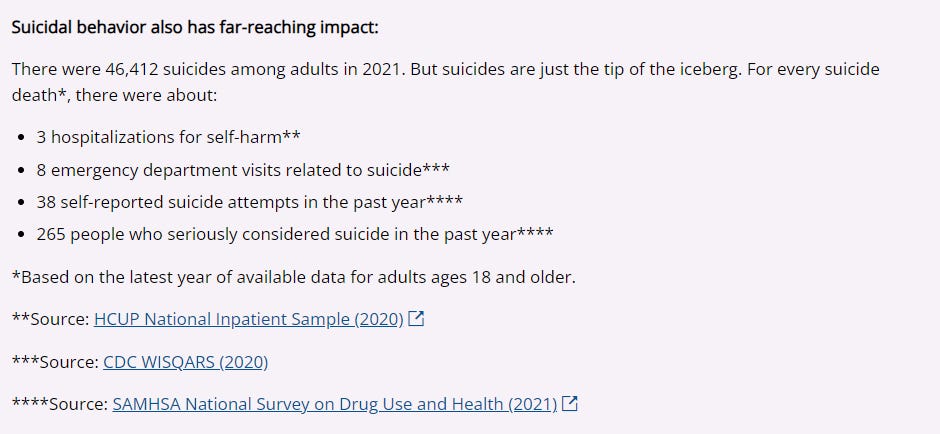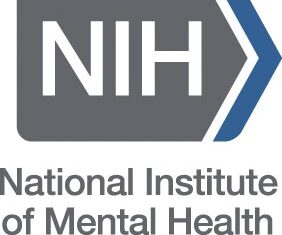
By Niha Jain, March 31st, 2024
If you or someone you know is having thoughts of suicide, it’s important to know that help is available and that suicide is preventable. The National Suicide Lifeline is available 24/7 via phone and text (988) as well as chat (988lifeline.org).
In Berkshire Hathaway’s latest annual report, Warren Buffett highlights an unexpected headwind for Berkshire-owned railroad company BNSF: suicide. Buffett laments that BNSF’s train conductors witness a suicide on the train tracks nearly every day:
An evolving problem is that a growing percentage of Americans are not looking for the difficult, and often lonely, employment conditions inherent in some rail operations. Engineers must deal with the fact that among an American population of 335 million, some forlorn or mentally-disturbed Americans are going to elect suicide by lying in front of a 100-car, extraordinarily heavy train that can’t be stopped in less than a mile or more. Would you like to be the helpless engineer? This trauma happens about once a day in North America; it is far more common in Europe and will always be with us.
With his singular ability to hone in on the most important trends and opportunities, the Oracle of Omaha is, as ever, onto something. Suicide is one of the biggest societal issues of our time: it is the 11th leading cause of death in the U.S. and a top 3 leading cause of death for people ages 10-24 (NIH).
In addition to the profound emotional pain experienced by those suffering from suicidal ideation and the loved ones of people who have committed suicide, suicide has massive, broader social impacts. Various studies tally the annual cost of suicide – including medical expenses, lost economic productivity, and decreased quality of life – at $50B to $500B in the U.S. In 2021, the U.S. Surgeon General published a Call to Action characterizing suicide as a major public health problem, similar to diseases like obesity and cancer.
Despite the vast human and economic costs of suicide, relatively few investors and entrepreneurs have taken up this issue, leaving it to government or assuming investments in broader mental health care will suffice. Billions of venture dollars have been invested mental health care startups, hitting record highs in recent years, but investment in startups focused specifically on preventing suicide has been comparatively paltry. Two of the best-funded suicide prevention startups, Vita Health and Oui Therapeutics – both founded by forensic psychiatrist and serial entrepreneur and investor Seth Feuerstein and invested in by CVS Health – have raised ~$60M in venture capital funding combined, according to Pitchbook. Another startup enabling evidence-based suicide care, Jaspr Health, has been primarily funded by grant dollars from the National Institute of Mental Health. With nearly 45,000 deaths from suicide each year in the U.S., and increasing suicide rates over the last two decades, why does suicide prevention receive so much less attention in the investment community relative to other leading causes of mortality and morbidity?
One reason for this funding disparity might be investors’ belief that suicide prevention is already being adequately addressed by the plethora of well-funded mental health companies.
Indeed, a 2023 report on VC investment from the American Psychological Association noted that “funders appear increasingly interested in technologies that cover a broad spectrum of mental health problems rather than specific ones.” This suggests VCs may not be as interested in companies solving for specific concerns like suicide, instead looking for broader “platform” solutions taking on multiple types of health issues.
There are a few challenges with this approach. The Surgeon General’s 2021 report emphasizes that suicide is not just a mental health problem that can only be treated by mental health specialists, but is rather a broader public health problem with many causes – from physical health challenges to a lack of financial security to social isolation and more – that should be addressed by a corresponding broad range of solutions. This lens suggests that general mental health care companies that lack specific care models for suicide are unlikely to solve the problem on their own. While companies treating depression – the most common behavioral health condition – do typically screen for suicidality, many do not have the specific care models and resources in place to respond well. A major barrier here is that the FDA has indicated it expects to oversee all digital tools that touch suicide. The rigorous and costly multi-year process of gaining FDA approval may deter behavioral health tech companies from integrating focused digital suicide care, leaving patients to fall through the cracks.
A second reason for investors’ reticence might be a belief that there isn’t sufficient evidence to design effective care models for suicide prevention. Fortunately, this is not the case. The Surgeon General’s report details three evidence-based approaches that have been shown to be effective in suicide prevention: 1) lethal means safety, 2) safe and effective care for suicide risk, and 3) enhanced crisis care systems.
Death by suicide is often an impulsive act, with just a handful of minutes from thinking about making an attempt and doing so. Lethal means safety entails “removing ready access to means that may be used in a suicide attempt (e.g., firearms, medications, illicit drugs, poisonous household chemicals, and materials that can be used for hanging or suffocation) [and] can mean the difference between life and death when a suicidal crisis occurs”, according to the Surgeon General’s report. With firearms accounting for the majority of suicides in the U.S., programs that enable people at risk of suicide to safely store their firearms have taken off in recent years. Similar safeguards can be taken to reduce the risk of suicide by poisoning and other means.
Safe and effective care for suicide risk has been defined by the evidence-based Zero Suicide framework for health care providers. The framework comprises seven elements, among them workforce training, comprehensive suicide risk assessment, and robust transitions of care at key moments such as hospital discharge. While discussion of the suicide crisis typically anchors on prevention, Zero Suicide views suicide care as prevention: caring for people with high levels of suicidal ideation or who are at high risk for a suicide attempt is key to preventing future attempts. The Joint Commission, the accreditation organization for U.S. hospitals, assesses hospitals’ suicide care using standards consistent with Zero Suicide, but a recent study conducted by the Joint Commission and Pew Research shows that many hospitals do not meet these standards today.
The Surgeon General’s report also recommends engaging people with lived experience (PLEs) in designing and implementing suicide care, as they can uniquely understand what it is like to experience suicidal thoughts and behaviors. Jaspr Health, whose digital tool supports providers in the emergency department and inpatient units to deliver evidence-based care to suicidal patients, was co-designed and tested with PLEs, and its patient-facing app includes stories shared directly by PLEs.
With rigorous evidence-based care, a number of programs have successfully reduced long-term suicide risk. The Surgeon General’s report mentions The Good Behavior Game in schools, the U.S. Air Force Suicide Prevention Program, and the Perfect Depression Care program conducted by the Henry Ford Health System.
Furthermore, enhanced crisis care systems can bolster the supports available for individuals when they are in a suicidal crisis or after they have experienced one. While someone in crisis might call a crisis call line such as 988 or end up in the emergency room or hospital, after this episode they may subsequently lose contact with the needed supports – potentially ending up back in crisis. The Surgeon General’s report notes that “Suicide risk is highest in the first few days after discharge from inpatient mental health and can stay elevated for months.” The report compares good crisis care to Air Traffic Control: “Much like the Air Traffic Control system never loses track of an airplane, a crisis care system should never lose track of a person at risk.” Such a system would go beyond today’s crisis hotlines, overloaded emergency rooms, and unwelcoming inpatient settings to include supports such as mobile crisis teams (crews that can be dispatched to help someone in crisis wherever they are), more comfortable settings for patients admitted to the hospital such as EmPATH Units, and follow-up calls after hospital discharge. Digital tools such as the Jaspr at Home app’s evidence-based safety plans – which patients can create when they are in the hospital and keep with them for a future crisis – can also help. Focused efforts that build on these types of evidence-based approaches could make a real difference in preventing suicide.
Despite the real opportunity to improve care, a third reason for the funding and entrepreneurship gap might be a belief that there is insufficient stakeholder willingness to pay for suicide care. In reality, the economic high cost of suicide attempts creates a meaningful incentive for governments, employers, and health insurance plans to invest in suicide prevention and care. While it was somewhat difficult to find recent data sizing the cost, research by the health economics professor Donald Shepard found that the average economic cost per suicide attempt was $13,294 in 20131, which is $17,709 when inflation-adjusted to 2024. Patient reports suggest the medical costs alone for suicide attempts can be in the tens of thousands of dollars, especially those that require ambulances, inpatient stays, ICU care, or other complex care. Given that there are multiple suicide attempts, ED visits, and hospitalizations for every suicide, significant healthcare costs could be eliminated by preventing suicide attempts.

Source: https://www.cdc.gov/suicide/facts/index.html
This has not been lost on some health plans. CVS Health is an investor in both Oui Therapeutics and Vita Health and is implementing a comprehensive strategy – including making Vita Health’s telemedicine offering available to Aetna members – to reduce suicide attempts in its Aetna membership by 20% by 2025. CVS CEO Karen Lynch, who lost her mother to suicide, has publicly affirmed her commitment to suicide prevention and care.
On the provider side, many health systems have worked with the Zero Suicide Institute to implement better suicide care, and others have contracted with Jaspr Health to enable clinicians to deliver better care for suicide, despite somewhat limited direct financial incentives for health systems to invest in suicide prevention and care. Health systems have seen value in the Jaspr app’s clinical outcomes, including statistically significant improvements in the delivery of evidence-based suicide interventions and patient satisfaction ratings with their experience in the emergency department.
While suicide prevention has been a surprisingly overlooked area of healthcare, promising innovators such as those mentioned above are moving the space forward. Several startups are pioneering digital care for suicide, which can be more accessible (i.e., in the hospital, clinic, or home), scalable (i.e., requiring fewer care team members to implement), and evidence-based (i.e., more standardization, less room for human error). Vita Health is a telehealth provider specialized in suicide care. Oui Therapeutics is developing a digital 12-week suicide care program that can be prescribed to people at risk of suicide in the hospital, ED, or at home and is currently in clinical trials for FDA approval. Jaspr is providing evidence-based digital suicide care in the EDs of several large health systems, where overloaded care teams often can’t get to suicidal patients for many hours. Larger mental health care players are also starting to provide tailored suicide care models; for example, venture-backed mental health care company Lyra Health is launching care programs for serious mental illness, which will include virtual dialectical behavioral therapy for suicidality.
While skeptics may question the value of digital interventions, a 2023 JAMA meta-analysis suggested app-based interventions can be effective for treating moderate and severe depression (a common cause of suicide) and a 2024 journal article suggested using a GPT-based chatbot such as Replika could reduce suicidal ideation in students experiencing loneliness. Of course, new startups and care models will still need to demonstrate clinical outcomes to build trust with clinicians and patients and scale beyond early adopters. They will also need to gain broader payer reimbursement, and endorsements from regulatory bodies such as the FDA and USPSTF will help with that.
Successful businesses and outsized venture returns are built not just on great ideas and execution, but on bringing these to fruition at the right time. Suicide prevention and care sit at the confluence of factors that make for a timely opportunity to do well and do good: an unfortunately large and growing “market”, greater societal openness to talking about mental health, a clear savings opportunity for payers that are increasingly financially strained by growing healthcare costs, robust evidence-based care models, and growing adoption of digital care. In the morass of misaligned incentives in healthcare, implementing better suicide care is the rare point of consensus across patients, payers, providers, and government.
Thank you to everyone who helped me to learn about suicide prevention and care – especially Linda Dimeff, Seth Feuerstein, and Julie Goldstein Grumet for your important work in this field, Donald Shepard for your research and guidance on quantifying the costs of suicide, Alyssa Reisner and Julia Keene for your perspective on CVS Health Ventures’ investments in suicide prevention, and Richard Mockler for sharing your wisdom and feedback on this blog post.
Source: Warren Buffett and the Case for Investing in Suicide Prevention and Care (substack.com)




